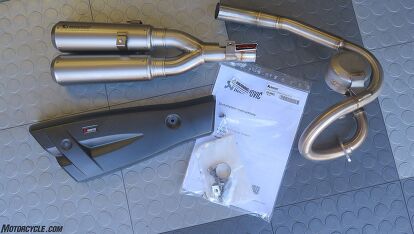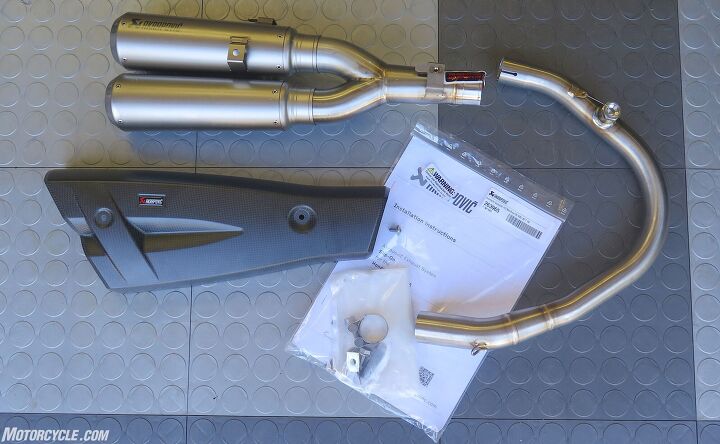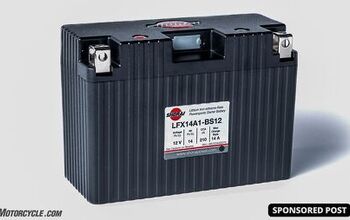MO Tested: Akrapovic Exhausts for Honda Monkey
Slip-on and Full!
I don’t even know whose idea it was to put an Akrapovič pipe on a perfectly good Honda Monkey, but it fell to yours truly to do the deed. And in fact I was happy to do it – to get out of the office for a day and hang with our good friend Chris at MotoGP Werks in beautiful Anaheim, California. It all takes me back to the day when new exhausts were the first thing we did to unleash the anger in our neighbors, followed by weeks of tinkering with jet kits and dousing ourselves in gasoline to try to get the bike to run as good as it used to. I kid, those things really did used to make big performance differences – but it seldom seemed as easy as the directions made it out to be.
The Monkey, however, couldn’t have been a much more agreeable patient. Akrapovič sent us two exhausts in one, really. The first consists of a stainless mid-pipe that slips onto the stock header (which contains an under-engine catalyzer), i.e., a slip-on cat-back system. And the other, full system, replaces the whole dang stock exhaust. They probably both render your Monkey “closed-course use only,” but that depends on where you live and isn’t our concern today, bro.
JOB ONE: The Slip-On
The stock system fairly fell off the Monkey. It’s built to last forever and to not cost much, so it’s flat-black steel and not exactly light. Logically we stuck on the slip-on system first. The hardest part of that was removing the cylindrical gasket deal from the stock pipe to use with the new mid-pipe, as Akra does not include a fresh one – but Chris has all the tools, and it was easy enough for him to extract it for re-use. For me at home, it might have been a more stressful procedure.
Anyhow, once that gasket was free, it was too easy to slip the new Akra midpipe into the Monkey’s stock header and tighten the clamp. Midpipe then slips perfectly into new muffler section, and the two are held together by a nice spring just like the ones on my old R1 Akrapovič system. (Chris also has a nice spring tool, which he gave me after I shot the spring across the shop twice trying to get it on with pliers and bled in his shop.) One bolt with 13mm head then bolts the Akra muffler on at the stock location, and though I looked through all the packaging material, I uncovered no nice rubber grommet to insulate pipe from frame like the stock Honda item uses. Pity.
From there, fitting the very nice carbon fiber heat shield was also fairly easy except that we needed to enlarge the rear heat-shield hole in order to use the bolt from the stock pipe, as Akra did not include that hardware either, nor the third heat shield fastener that goes on the top rear of the shield. Slightly aggravating.
And then it was dyno time. The stock bike crushed the Dynojet roller to the tune of 7.94 horsepower at 6700 rpm; the slip-on ramped that up to 8.67 also at 6700. Not much of a gain in hard numbers, but that’s a 9% bump in peak power, and easier to see on the graph.
Even easier to see is the slip-on system’s nice gain low in the power band between 2500 and 4000 rpm. At 3500, the modded bike’s making 21% more torque than the stocker, mostly because the new Akrapovič has thrown the 80 dB noise limit to the wind. The Akra maintains that nice bump in power throughout most of the rev band, falling slightly behind the stocker again as the fun is drawing to a close between 8500 and the 9000-rpm redline, an rpm range you’re not using anyway. Yeehaw.
Full System
To mount the full system, you drop the stock exhaust header/catalyzer from beneath the Monkey via three 12mm bolts, and insert the Akrapovič piece in its place, losing about 5 pounds of unsightly black steel plumbing in the process.
On the dyno, the full system sounds a bit less loud than the slip-on. Maybe it’s that round resonator that absorbs a bit of racket. Now we’re cracking the 9-hp barrier all the way from 6500 to 6800 rpm – 9.02 at 6800 rpm! That’s a 13.6% bump over the stock pipe, and a fair bump above the slip-on from 8000 to redline. Woooohoooo!!
Way less impressive, though, would be the full system’s disappointing bottom end. From 2500 to 4500 rpm, it’s making less, or barely more power than the stocker. The shorter length of the Akrapovič head pipe is making that top-end power at the expense of low-rpm grunt.
Real-World Testing
With the full system in place, top speed was 58 mph downwind, 54 upwind on the four-lane thoroughfare a block behind my house – and it was easy for my testing assistant to aurally keep track of wherever I was in the test loop from the back patio.
Swapping back to the slip-on system, a throatier bark was immediately noticeable upon hitting the starter button, and the low-rpm power boost was both heard and felt immediately upon pulling out of the pits (driveway) and onto the test circuit in second gear. Now top speed grew to 60 mph downwind and 55 against – exactly the opposite of what you’d expect given the full system’s bigger top-end numbers.
On a longer straight, maybe the full system’s on-paper hp advantage would eventually produce higher top speed as well, but in the real world the slip-on system’s noticeably superior low-rpm gets it up to top whack sooner. With the full system in place, there really didn’t seem to be much speed left with the digital speedo reading 58 for quite a while.
My assistant said she could still hear my entire circuit even when she retreated inside the house, and that the slip-on system is even louder than the full one. Pardon our not having a decibel meter, but these are both on the cusp of neighbor-annoyingly loud. If you’re never going to ride early on weekends or come home late at night, they’re fine – or if you’re only going to use your Monkey for a pit bike at the track where everybody appreciates loud engines, okay. Or if you’re 18 and everybody expects you to be an idiot.
Then again, things have gotten rather smug and suburban around here lately, and maybe a little more racket wouldn’t be a bad thing. I’d say if you’re going to get serious and make other Monkey mods, like bumping compression up from its 9.3:1 stock ratio and/or adding a cam, you might want to go for the full system. For juvenile delinquenting around town, though, the slip-on and its enhanced low-end are the hot set-up. Plus, you keep the catalyst and your non-gross polluter status.
In any case, with both pipes, our Monkey’s fuel injection seems to have enough latitude to fatten the mixture to go with the increased airflow – though playing with the ECU would probably produce even better power. Save for that weird anomaly on the dyno chart at 8000 rpm, which I can’t really feel, the little chimp runs just as well as it did before, and without a single backfire. Even with the Akrapovič, though, my assistant was still able to dispatch the Monkey with ease on a PCX150 scooter at every stop, loading up the 149 cc thumper and automatic trans against the front brake to get monster holeshots.
Visually, not even the exotic-bike jaded Chris Redpath at MotoGP Werks could deny the visual impact of the Akrapovič’s tasteful assemblage of stainless steel, titanium and carbon-fiber. Akrapovič claims the slip-on system removes 4 pounds from the Monkey, and the header another 4.6 lbs. If you must molest your Monkey – and I think we’ve all been there haven’t we? – this is a top-notch way to do it.
Part Number/MSRP:
S-H125SO3-FFSS (Slip-On System) – $624.24
E-H125R1 (Stainless Header) – $210.00
P-HSH125R1 – (Carbon-Fiber Heat Shield) – $162
More by John Burns
























































Comments
Join the conversation
"They probably both render your Monkey “closed-course use only,” but that depends on where you live and isn’t our concern today, bro."
Nope. Federal law applies to all 50 states. If it isn't tested and certified for road use it is illegal. Emission tampering per occurrence is a $2,500 fine for an owner, $10,000 fine if the tampering is done by a manufacturer or dealer. Thankfully the EPA is starting to crack down on dealers.
re:enlarging the holes in the c.f. heat shield
How did you proceed? I've seen some abstinence-only warnings about carelessly abrading that stuff.
https://www.youtube.com/wat...